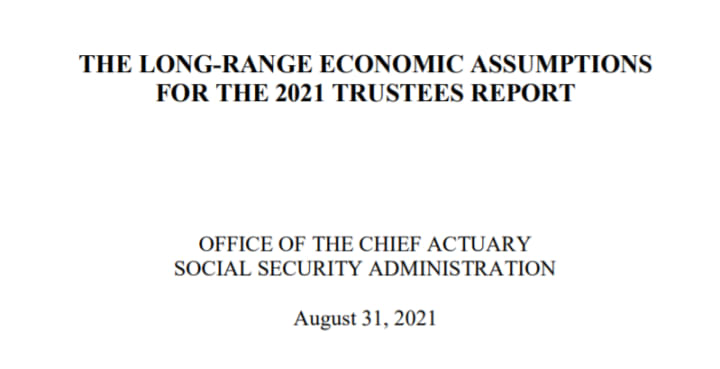Social Security Will Run Dry by 2034 According to Report
The Social Security system funds could be 'depleted'

The Social Security Trust Funds will become “depleted” by 2034 according to a recent report by its Trustees. This is one year earlier than projected last year, according to a press release on Aug. 31 by the Social Security Administration.
This new report reflects the impact of Covid-19 on the available funds in the Trust Funds. The net result is that by 2034, the government will only be able to pay out 78% of the scheduled benefits at that time.
However, a closer look at the Report shows that a number of the assumptions in the report don’t stand up to scrutiny. The net result is that the Social Security Trust Funds could face earlier depletion than by 2034.

Errors in The Report’s Assumptions
One interesting way to analyze the Report is to look at its assumptions. The Chief Actuary of the 2021 Trustees Report put out a publication on the material assumptions underlying their forecast.
One of the most interesting is on page 4 of the report. They assume that inflation will only reach a peak of 3.0% maximum over the period of the projections (75 years).
This low inflation rate is already well below the inflation rate we are experiencing today. For example, I wrote an article earlier this week showing that CPI inflation is now over 6.8%. This is from the Bureau of Labor Statistics Dec. 10 press release showing that it has increased from Nov. at 6.2% to 6.8% over the last 12 months.
In other words, we cannot even rely on one of the most important assumptions of the report. Inflation can ravage an economy, as we have seen from Venezuela’s experience. Even if inflation did not influence the depletion rate of the Trust Funds (which is unlikely), the cumulative effect of a much higher inflation rate will make most of the Trust Fund benefits much less valuable over time.

Demographic Realities Don’t Match the Report
Another highly unrealistic assumption in the Report relates to the assumption about immigration. The report refers to two types of immigrants: lawful permanent residents (LPR) and “other than LPR.” The problem is that the Chief Actuary’s Assumptions about demographics is that it underestimates the “other than LPR” category.
For example, on page 45 of the Report, the assumption is made that in 2021 only 185,000 enter the US as illegal immigrants (i.e., “other than LPR”). And for 2022 it assumes 652,000. It slowly increases the number to 1,039,000 in 2023 and slowly lowers it to 994,000 by 2025 and 514,000 by 2030.
Of course, this is not what is happening now. According to the Pew Research Center, as of July 2021, there were almost 200,000 migrants (199,777) coming across the border in July 2021 alone. This is at a 21 year high, up from just 16,182 in April 2020.
Therefore, assuming that these numbers have not abated, that could mean over 2,000,000 have entered the US this year alone. This is significantly higher than the 185,000 assumed in the Chief Actuary’s report for 2021.
So assuming this high rate of immigration continues, the Social Security Trust Funds will likely be “depleted” much sooner than 2034.
Bottom Line — Expect More Alarming Updates
If these two simple assumptions are so far off-base, how many other assumptions in the Trustee’s Report are in error? As a result, I highly suspect that we can expect to see more updates that are alarming in terms of when the Trustees expect depletion of the Funds.
If this is the case, no one who is relying on Social Security should be surprised if major changes are made to the program in the next five years.
This could include higher payroll taxes, lower benefits, longer times paying in, and higher levels of income subject to payroll taxes. And who knows if the Trustees will simply say that some lower percentage than 100% of benefits will be paid out?
The worst effect could be that inflation ravages the purchasing power of the benefits that are actually paid out. In that case, there would be little reason for existing payroll taxpayers to continue participating in the system. This could have the potential of encouraging opt-out and non-payment by many participants in the Social Security system.
The bottom line is that Report does not realistically portray the downside case for the Social Security system.
Mark Hake writes articles on InvestorPlace.com, Medium.com, and Newsbreak.com on stocks and cryptos and also runs the Total Yield Value Guide which you can review here.
He is a top-ranked financial writer, ranked 5 stars by TipRanks.com in the top 0.30% of all financial bloggers with an average return of over 20.0% on over 500 stock and crypto articles in the past year.
About the Creator
Mark R Hake
Mark Hake is a financial writer for InvestorPlace, and writes as well on Medium.com and Newsbreak.com. He is a Chartered Financial Analyst (CFA) and has been an owner of a hedge fund, money management firm, and an investment research firm.






Comments
There are no comments for this story
Be the first to respond and start the conversation.